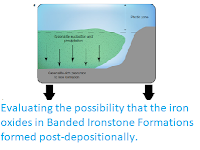Most familiar organisms respire using oxygen, a process in which the oxygen is 'reduced' by when it accepts an electron from a donor atom, typically carbon (electrons have a negative charge, so the charge on the oxygen atom goes down when it accepts an electron, hence it is reduced, even though it has gained something). Many Bacteria, however, respire using sulphur instead, a system of respiration that is thought to be older than oxygen respiration. Many enclosed ocean basins, such as the Black Sea, have a heavily stratified water column (i.e. little movement of water between upper and lower layers), with an oxygen rich upper layer, with abundant oxygen-respiring Bacteria, and a sulphur rich bottom layer, with many sulphur-respiring Bacteria. Between these layers is a middle layer lacking abundant sulphur or oxygen, but yet which appears to host a large Bacterial population, particularly immediately above the sulphur-rich layer, where something is actively fixing carbon from carbon dioxide at a high rate. Quite what the Bacteria in this layer might be respiring is unclear; the element manganese has been suggested as a possible electron acceptor which would be present in these waters, but to date no manganese-respiring Bacterium has ever been discovered.
In a paper published in the Proceedings of the National Academy of Sciences of the United States of America on 3 June 2019, Jan Henkel of Biological Oceanography at the Leibniz Institute for Baltic Sea Research Warnemünde, Olaf Dellwig of Marine Geology, also at the Leibniz Institute for Baltic Sea Research Warnemünde, Falk Pollehne, also of Biological Oceanography at the Leibniz Institute for Baltic Sea Research Warnemünde, Daniel Herlemann, again of Biological Oceanography at the Leibniz Institute for Baltic Sea Research Warnemünde, and of the Centre for Limnology at the Estonian University of Life Sciences, Thomas Leipe again of Marine Geology at the Leibniz Institute for Baltic Sea Research Warnemünde, and Heide Schulz-Vogt, once again of Biological Oceanography at the Leibniz Institute for Baltic Sea Research Warnemünde, describe a new species of Bacterium from the Black Sea, which is able to respire manganese.
The Bacterium was collected in November 2013 during a voyage of the Research Vessel Maria S. Merian to the Black Sea, which sampled water from several layers within the suboxic zone. They found a high prevalence of Epsilonproteobacteria (a group which includes the pathogenic Helicobacter and Campylobacter, as well as marine bacteria responsible for the fixation of carbon from carbon dioxide below the photic zone) within a layer above the sulphur-rich layer, which contained hydrogen sulphide (i.e. reduced sulphur, which can act as an electron donor), but not a recipient), but no oxygen or nitrates (which are known to be respired with hydrogen sulphide by some bacteria). From this they were able to obtain an unknown species of Sulfurimonas, which appeared to be closely related to Sulfurimonas gotlandica, a species known to respire nitrates with hydrogen sulphide.
The new species is named Sulfurimonas marisnigri, where 'marisnigri' means 'Black Sea' in Latin. It was found to be able to respire manganese dioxide with hydrogen sulphide, making it the first known Bacterium to be able to gain energy using manganese as an electron acceptor, and also to be able to fix carbon dioxide from the water column, producing manganese calcium carbonate. The cells of Sulfurimonas marisnigri are slightly curved, and 1-4 μm in length.
Scanning electron microscopy image of the isolate Sulfurimonas marisnigri. Henkel et al. (2019).
Henkel et al. note that unknown species of the genus Sulfurimonas are abundant in the oceans, both in open pelagic waters (waters not near land) and around hydrothermal vents and in marine sediments, environments in which manganese respiration is thought to be occurring, producing large amounts of sulphates and manganese calcium carbonate.
See also...
Follow Sciency Thoughts on Facebook.







